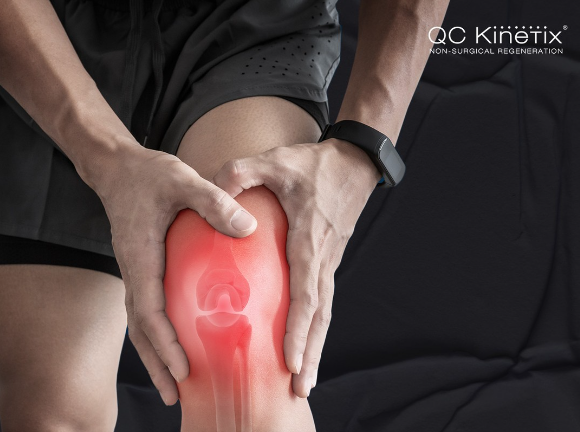This blog post is written by QC Kinetix. A Non-Surgical Regenerative Treatment Center. To learn more about their amazing approach to natural healing, I have added some information below. You can find more details at their website QC Kinetix and how you can get started.
The QC Kinetix center for regenerative medicine is the place to go when you think you’re out of options for resolving your pain. Have you been told invasive surgery is your best choice? Are you hoping to avoid surgery? Have you tried everything to eliminate the pain and immobility of your condition without success? Come to QC Kinetix.
At QC Kinetix, our regenerative treatments go to the root of your pain to resolve it at its source. We don’t try to mask your pain or attempt to manage it for you. Instead, we use regenerative medicine to harness and engage your body’s natural ability to renew itself, providing improved function while avoiding surgery.
With many locations throughout the United States, QC Kinetix provides comprehensive regenerative medicine, including biologic therapies, laser therapy, nutritional support, and rejuvenating treatments. Our goal is to empower you against your pain.
We carefully discuss and detail our natural regenerative treatment options with each patient. While every patient may not be a candidate for our therapies, we help each one make the most appropriate decisions for their particular condition.
We treat everyone from professional athletes and weekend warriors to aging adults who want to remain active. Our regenerative treatment options don’t just mask your symptoms — they are designed to maximize your body’s ability to recover from the inside out. At QC Kinetix, we intend to provide you with improved function and mobility to enhance your quality of life.
5 Mistakes that Make Knee Pain Worse When Running
Picture this: You wake with the first rays of sunrise; the birds are tuning up for their morning symphony. Today’s agenda is packed, but the open road beckons. So, you skip stretching, grab your favorite well-worn running shoes, and stride out. The run feels great, the world blurs, and the sound of your feet pounding on the pavement matches the beat of your heart.
Your left knee twinges again, but you’re tough; you’re not a quitter. The runner’s high is kicking in — there’s nothing else like it. Others can spend their time sweating in gyms with strength training or other exercise; for you, it’s all about the open road.
What feels like a great way to start your day may, in fact, cause injury to your knees. By our count, you have made five mistakes that could make your intermittent knee pain a constant companion. Let’s investigate these mistakes so your next sunrise run revitalizes your body as well as your spirit.
1. The Importance of the Warm-Up and Cool-Down
Skipping the warm-up shaved a few minutes off your morning run, but it also short-changed your body and left your knees vulnerable to injury. So, next time, take the time to warm up and stretch before your run.
The warm-up and cool-down stages of your run are critical for the health of your knees. With every stride, your knees absorb tremendous shock while maintaining your stability. The warm-up slowly stretches and warms your muscles, ligaments, tendons, and joints. It raises the temperature of your body by increasing the blood flow to your knees and throughout your muscles and joints, lowering the risk of injury.
To warm up, try a brisk walk for a few minutes, followed by stretching before you take your run. Afterward, a brisk walk helps your body cool down gradually, preparing it for recovery.
Warm-ups prepare your body for activity. Warming up before running:
- Gradually increases heart rate, optimizing oxygen delivery to your muscles.
- Enhances the elasticity of muscle fibers.
- Prepares neural pathways for more efficient coordination.
Cool-downs prepare your body for recovery. Cooling down after running:
- Facilitates the removal of metabolic waste that builds up during the run.
- Prevents blood pooling in the lower limbs.
- Aids the restoration of normal muscle length and function.
2. The Silent Role of Running Shoes
Keep your broken-down running shoes for the memories, but don’t wear them for your next run. Your new running shoes don’t have to be expensive, but they do need to support you and your knees every step of the way.
Quality running shoes provide stability and support on every step of your run. They absorb tremendous force each time your foot impacts the ground and reduce stress on your knees, ankles, heels, and toes while supporting your arches. A good pair of running shoes helps to prevent injury and maintain your form throughout your run. Running shoes break down a little bit with every stride, so it’s recommended that you replace them every 300 to 500 miles.
Running places extraordinary stress on your knees. The load on the patella tendon ranges from 4.7 to 6.9 times your body weight with each step, while the patella-femoral joint experiences forces up to 11 times your weight. The cushioning engineered into running shoes helps to absorb and dissipate some of this stress. Research shows this essential equipment prevents injury and optimizes performance. Whether you’re an elite athlete or simply enjoy your daily run, a good pair of running shoes is critical protection your body deserves.
3. Your Running Form Matters
The heavy pounding of your feet on your morning run is a classic indicator of over-striding. Aim for a soft, rhythmic landing and a more gentle foot strike to safeguard your knees.
Your posture, your foot strike, and the way you move your arms and legs all impact your running efficiency and the impact on your body. A poor running form can increase the stress on your joints, particularly your knees. Even casual runners benefit from periodic form checks to ensure they don’t hurt themselves. Check your running form with a buddy, try a smartphone app, make a video of yourself running and compare it to YouTube tutorials, or consider a professional gait analysis. You only have one set of knees, but many ways to protect them.
Proper running form ensures energy-efficient use and minimizes wear and tear on your joints, especially your knees. Over-striding, which occurs when your foot lands too far in front of your center of gravity, can increase the braking force on your knees. Poor running mechanics like over-striding increase the load on the knee joint, the anterior cruciate ligament (ACL), and the menisci.
4. Listen When Your Body Speaks
The next time you experience pain as you’re running, pay close attention. Slow your pace and evaluate. If the pain is sharp or intensifies, stop running altogether. Try gently stretching, but don’t exacerbate the pain. If slowing down eases the pain, try walking briskly for a bit, then slowly pick up the pace. Most of all, listen to your body.
Pain is one of many ways your body speaks to you. While a little discomfort lets you know you’re pushing your limits, a sudden or sharp pain should not be ignored. Pain is a protective mechanism alerting you to changes in your body’s condition. If the pain is caused by a minor injury, continuing to run may exacerbate and compound the damage.
While your brain may disregard your body’s messaging, your body can’t. Running through the pain often results in changes to your gait as your body strives to avoid the pain. These gait changes can overload muscles and joints, risking further injury. Running experts recommend that if the pain intensifies as you run — or if it persists for 10 minutes — stop.
5. You Need Cross-Training
Incorporating cross-training into your fitness regimen will help you to run longer without injury.
Cross-training is essential for professional athletes, but even casual runners can benefit from diversifying their fitness regimen. Cross-training promotes balance between opposing muscles. While running develops the quadriceps, cross-training exercises, weight-training, pilates, and yoga can strengthen the hamstrings, preventing injury. By strengthening and stretching the muscles, ligaments, and tendons around the knee, you create a stronger, more stable support network for the knee.
While cross-training offers several benefits, the greatest is the prevention of injury. Runners experience many types of injuries, but most are related to biomechanical imbalance and overuse. Cross-training lets you strengthen specific muscle groups to correct the imbalances caused by the repetitive stress of running. Cross-training promotes more even muscle development, easing the strain on your knees.
Adjusting your running regimen will protect your knees and the rest of your body as you chase that runner’s high. So, make time to warm up and cool down, chuck your ratty running shoes, and check that your running form is good. Listen to your body and incorporate other types of exercise into your routine.
Knee pain is one of the leading reasons people seek regenerative therapy. While regenerative medicine can help your body repair injured tissue, preventing injury is always best. Here’s to healthier knees, better choices, and countless miles ahead.

